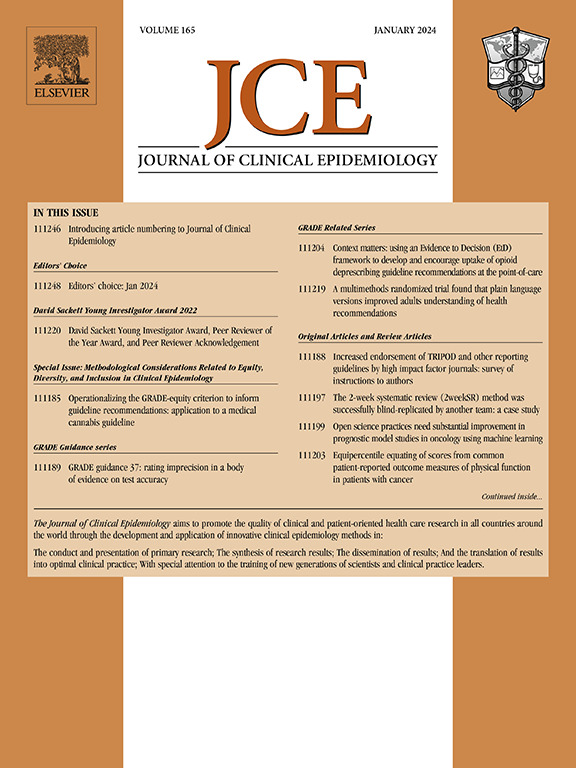Carbon emissions associated with clinical trials: a scoping review
IF 7.3
2区 医学
Q1 HEALTH CARE SCIENCES & SERVICES
引用次数: 0
Abstract
Objectives
To review and synthesize available evidence on carbon emissions associated with clinical trials to inform future research on design and delivery of greener trials.
Study Design and Setting
We performed a scoping review by following the Joanna Briggs Institute guidance and the Preferred Reporting Items for Systematic Reviews and Meta-Analyses Extension for Scoping Reviews. A systematic search was conducted on MEDLINE (Ovid) from January 1, 2007, to April 15, 2024, with no geographic and language restrictions complemented by forward and backward citation analysis (snowballing). We included all types of research literature within the context of clinical trials reporting any aspect related to trial specific carbon emissions.
Results
Twenty-two articles were identified as eligible and included in the review. Most included studies (n = 17, 77%) were published between 2020 and 2024. Over half of the included studies (n = 13, 59%) were primary research articles with the majority reporting carbon audits of trials and their associated processes. The remaining literature comprised secondary studies (n = 3, 14%) and opinion pieces (n = 6, 27%). Diverse and evolving approaches to studying trial-related carbon emissions were identified alongside several carbon hotspots including those associated with trial-related travel, trial facilities, and sample lifecycle.
Conclusion
The literature on carbon emissions associated with clinical trials has focused on studies reporting carbon audits of trials and their associated processes. Efforts have been made to quantify the trial carbon output with variability in methods and carbon output. Despite the development and evolution of carbon measurement tools, strategies to mitigate trial specific carbon emissions are still much in need.
Plain Language Summary
Clinical trials are important to the development of medicine and health care but they have great unintended environmental impacts, especially in the form of carbon emissions. We looked at the literature to understand how carbon emissions generated by clinical trials were measured, which components across trials were carbon heavy, and what could be done to reduce the carbon output of clinical trials. We found 22 relevant articles of which 13 were primary research studies. Twelve of these primary studies measured carbon output of a range of trials. Their results varied considerably because of the variability of a host of factors, such as the number of trials analyzed, trial duration, geographical scope, trial processes measured and methods for quantifying carbon emissions. Despite varied definitions of carbon hotspots, several trial activities, including trial-related travels and meetings, trial facilities, and sample and laboratory activities, were found to be carbon heavy across studies. The remaining primary research surveyed the awareness of trial carbon impact. The rest of the 22 articles consist of three secondary research studies and six opinion papers. All of them called for attention to the carbon emissions of clinical trials and offered recommendations for reducing the carbon footprint of trials. This review identified evidence that was dedicated to measuring carbon footprint of clinical trials. Despite the challenge to compare their results because of their different approaches to carbon measurement, several carbon intensive trial processes were found to be common across studies. We still require research on how to minimize the carbon output of clinical trials.
求助全文
约1分钟内获得全文
求助全文
来源期刊

Journal of Clinical Epidemiology
医学-公共卫生、环境卫生与职业卫生
CiteScore
12.00
自引率
6.90%
发文量
320
审稿时长
44 days
期刊介绍:
The Journal of Clinical Epidemiology strives to enhance the quality of clinical and patient-oriented healthcare research by advancing and applying innovative methods in conducting, presenting, synthesizing, disseminating, and translating research results into optimal clinical practice. Special emphasis is placed on training new generations of scientists and clinical practice leaders.
 求助内容:
求助内容: 应助结果提醒方式:
应助结果提醒方式:


